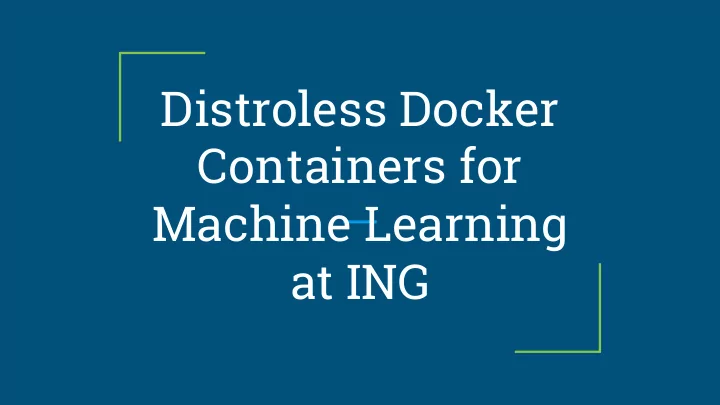

Distroless Docker Containers for Machine Learning at ING
About me - Bachelor of Computer Science at Delft University - Currently doing my Master’s in Computer Science - Specializing in Data Science - Working as a machine learning engineer at ING bank - Productionalizing Machine Learning - First time giving a talk (scary!)
What I’ll be talking about today - Some context: machine learning in production - A journey of a simple use case - Analyzing our use case - Distrofying our use case
Machine Learning in production - Many teams, many models - Having each team manage their model and exposing an API does not promote uniformity within an organisation
Enter: The Machine Learning Platform - Many models on one infrastructure - ‘Container platform’ - Specialized pipelines for data scientists - Model orchestration - Many models running in their own environments - Excellent use-case for containers!
Machine Learning, some concerns - Machine learning models handle sensitive data - Combination of features can lead to identification - Anonymization is very difficult! - Parameters of a machine learning model may be used maliciously or may also contain sensitive information - For example: transforming words into vectors - This talk: be aware of the container your model runs in
Our little model
Our little model from sklearn.ensemble import RandomForestClassifier from sklearn import datasets iris = datasets.load_iris() model = RandomForestClassifier() model.fit(iris.data, iris.target)
Our little model, continued import numpy as np from flask import Flask, request, jsonify app = Flask(__name__) @app.route('/predict', methods=['POST']) def predict(): data = request.json["data"] prediction = model.predict(np.expand_dims(data, axis=0)) return jsonify({"result": int(prediction[0])})
Our little model, a quick test $ flask run $ curl -H 'Content-Type: application/json' \ -d '{"data": [5.9, 3.0, 5.1, 1.8]}' \ -X POST http://localhost:5000/predict Returns... { "result": 2 }
Our little model, dockerized FROM python:3 WORKDIR /usr/src/app COPY requirements.txt ./ RUN pip install -r requirements.txt COPY app.py app.py CMD ["flask", "run"] $ docker build -t my-python-app:1.0.0 . $ docker run -p 5000:5000 --name app my-python-app:1.0.0
Our little model, a quick test flask run curl -H 'Content-Type: application/json' \ -d '{"data": [5.9, 3.0, 5.1, 1.8]}' \ -X POST http://localhost:5000/predict Returns... { "result": 2 }
Scanning images - Dynamic analysis - We can actively monitor the running container - Static analysis - We can perform analysis before running the container
Scanning images, static analysis with clair - Simply specify the image! $ clair-scanner -r report.json --ip docker.for.mac.localhost \ my-python-app:1.0.0
Inspecting the image, miscellaneous - The size of the image is quite large, 1.1 GB - Any user who is part of the docker group can attach a shell and modify the docker container $ docker exec -it --name app sh # ls ...
Distroless, what is it? “"Distroless" images contain only your application and its runtime dependencies. They do not contain package managers, shells or any other programs you would expect to find in a standard Linux distribution.” https://github.com/GoogleContainerTools/distroless
Our little model, revisited FROM gcr.io/distroless/python3 WORKDIR /usr/src/app COPY requirements.txt ./ RUN pip install -r requirements.txt COPY app.py app.py CMD ["flask", "run"] $ docker build -t my-python-app:1.0.0 . /bin/sh: 1: pip: not found
Our little model, revisited, multi-stage FROM p ython:3.5 AS build COPY requirements.txt . RUN pip install -r ./requirements.txt FROM gcr.io/distroless/python3 COPY --from=build /usr/local/lib/python3.5/site-packages/ \ /usr/lib/python3.5/. ENV LC_ALL C.UTF-8 WORKDIR /usr/src/app COPY app.py app.py CMD ["-m", "flask", "run"]
Inspecting the image, miscellaneous - The size of the image is smaller, 250MB, quite a significant reduction! - Any user who is part of the docker group can attach a shell; however, it is more difficult to modify the docker container docker exec -it --name app sh # ls - sh: 1: ls: not found
But we can do better! - If we inspect the image, 50MB originates from the distroless image and 200MB from the python dependencies!
A short introduction, PyInstaller - PyInstaller allows us to freeze our dependencies - This way, we can decrease the size of our images significantly!
Our little model, some changes $ flask run app = Flask(__name__) ... if __name__ == "__main__": app.run() $ python app.py
Our little model, with PyInstaller FROM python:3 AS build WORKDIR /usr/src/app COPY requirements.txt app.py ./ RUN pip install --upgrade pip --upgrade setuptools && \ pip install -r requirements.txt && \ pyinstaller app.py FROM gcr.io/distroless/python3 COPY --from=build /usr/src/app/dist /usr/src/app/dist ENTRYPOINT [“/usr/src/app/dist/app”]
Our little model, attempt #1 $ docker run my-distroless-python-app:1.0.0 ModuleNotFoundError: No module named 'sklearn.utils._cython_blas' - Sometimes we have to help PyInstaller find imports through specification files
Our little model, PyInstaller spec file a = Analysis(['app.py'], ... hiddenimports= [ COPY requirements.txt \ 'sklearn.utils._cython_blas', app.py app.spec . 'sklearn.ensemble', ... 'sklearn.neighbors.typedefs', RUN pyinstaller app.spec 'sklearn.neighbors.quad_tree', ... 'sklearn.tree._utils' ], datas=collect_data_files(‘sklearn.datasets’) )
Our little model, attempt #2 $ docker run my-distroless-python-app:1.0.0 * Running on http://127.0.0.1:5000/ (Press CTRL+C to quit) - The size of the image has been reduced to 97MB!
Our little model, further improvements - Bundle PyInstaller executable with python library files and use scratch image
Lastly, Some docker tips - Don’t run as root - Use image hash instead of image name and tag - Build your own distroless images - Sign docker images
To summarize - Be careful in which images you choose for your models - Use smaller (distroless) images to limit possible exposure to vulnerabilities
Thanks so much! - Code highlighter for slides: - https://github.com/romannurik/SlidesCodeHighlighter - Clair-scanner: - https://github.com/arminc/clair-scanner - Awesome libraries used: - https://github.com/matplotlib/matplotlib - https://github.com/numpy/numpy - https://github.com/scikit-learn/scikit-learn - https://github.com/pallets/flask - https://github.com/docker/docker-ce
Recommend
More recommend